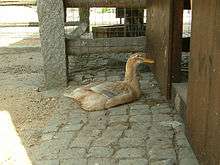Saxony duck

The Saxony is a breed of domestic duck originating in the Saxony region of Germany, roughly 25 miles from the Czech Republic border[1].
History
The breed was initially bred and developed by Albert Franz of Chemnitz in the 1930s, but almost all of his original stock was lost during World War II. He cross bred Rouen, German Pekin, and Blue Pomeranian ducks in his attempt to develop a new multipurpose breed[1]. Resuming his efforts, Franz's work resulted in the recognition of the Saxony by 1957, in Germany[1]. In 1984, David Holderread (who later developed his own breed, the Golden Cascade), imported some Saxony ducks to the US, and it was recognized by the American Poultry Association in 2000 by admittance in to the Standard of Perfection. Saxony in North America are considered critically endangered by the American Livestock Breeds Conservancy, with less than half a dozen breeders total according to their 2000 census.
Characteristics
The Saxony is classed as a heavy duck, weighing between seven and nine pounds, making it an excellent table bird[1][2]. It is considered to be beautiful bird suited to both watching and petting. Females may lay 200 or more large white eggs in a year[1]. The name Saxony represents both the breed and the color variety[1]. With regards to body type and frame size, the Saxony resembles the Appleyard duck. Saxony ducks are a heavily muscled breed with tight feathering. The head is oval-shaped and is moderately large. Saxony ducks have deep, full breasts with lots of width that is carried across the back of the bird and extends towards the tail. Abdomen should be broad and full, free of keel development as seen in exhibition-type Rouen ducks[2]. Saxony have a carriage above 20º-30º above horizontal. Both drakes and hens have yellowish bills with orange legs and feet. Drakes resemble a diluted Mallard in hue, while females are a rich, light buff color with white streaks on the face with some blue-gray shading[2].
Saxony ducks are considered excellent foragers[1].
References
- 1 2 3 4 5 6 7 Holderread, Dave (2001). Storey's Guide to Raising Ducks. North Adams, MA, USA: Storey Publishing. pp. 85, 86.
- 1 2 3 Standard Revision Committee; Malone, Pat; Donnelly, Gerald; Leonard, Walt (2001). American Standard of Perfection. USA: American Poultry Association. p. 370.
- Ekarius, Carol (2007). Storey's Illustrated Guide to Poultry Breeds. Storey Publishing. ISBN 978-1-58017-667-5.
- "Saxony Duck". Rare Breeds Watchlist. American Livestock Breeds Conservancy.
- "Saxony". feathersite.com.